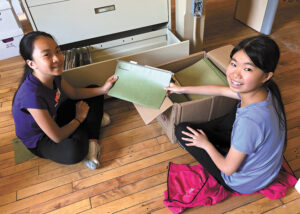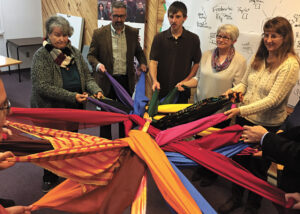Throughout COVID-19, schools and universities across the country have moved between learning in the classroom and online remotely. But what about education happening outside of traditional academic settings?
Many people have taken the different rhythm of life the pandemic has created as an opportunity to start learning and teaching in new ways.
When asked on Twitter and Facebook whether any Mennonites have been learning new skills during COVID-19, more than 30 people responded. Mennonites ranging from 20-year-olds to those in their 90s, from across Manitoba and even as far as Oregon and South Carolina, shared about their ventures.
Many crocheted, knitted, weaved and sewed, while others learned to compose music and play instruments like the guitar, bass and stick dulcimer. Some made cheese, portzelky (new year’s cookies) or beef rouladen for the first time. One person even built a canoe in his garage.
As our dependency on screens skyrocketed, more people began to reclaim the tactile knowledge that some are forgetting in this digital age:
Jess Klassen of Charleswood Mennonite Church, Winnipeg, has been sewing most of her own clothes for a while. When the pandemic began, she created an Instagram account to share her projects and engage in the online sewing and slow-fashion community.
“The act of creating during the pandemic has been life-giving for me,” she says. “Amidst the various waves, periods of isolation, uncertainty and relentless parenting, I have prioritized making time to create with my hands. In addition to sewing, I’ve picked up crocheting and punch needle during the pandemic. I learn new stitches and techniques on YouTube and get continual advice and inspiration from the making community on Instagram. . . .
“[It] adds new beauty and connection to my daily life. It not only connects me to new friends, but it connects me to generations past, particularly my grandmothers, who were avid seamstresses, makers and rug hookers.
“My parents share new stories with me about their memories of their mothers’ making during their childhoods, and I can only hope that my kids also have fond memories of new creations in the house and yarn on the bottom of their socks.”
Emily Stobbe-Wiebe of Carman (Man.) Mennonite Church, meant to start quilting five years ago but put it off when life got busy. Then pandemic lockdowns hit.
“Just before Christmas I thought to myself, ‘This is silly. It will never be less busy than this. I might as well get started,’ ” she says. “So, I went to Fabricland and bought supplies and borrowed a sewing machine. I reached out to a woman at church, whom I knew did quilting, and she has been answering my questions. I greatly appreciate having someone to guide me through the process of learning a new skill. . . .
“I miss learning new things, not being in school at the moment. I get a lot of joy from creating useful things, and repetitive, methodical work helps me de-stress. . . .
“I am at the beginning of this practice, so it can still be very frustrating, and I have a lot to learn. But in many ways, I am thankful for the way the pandemic has allowed me the space to be solitary, to think and reflect, to understand myself and what is really important to me, what helps me be a healthy person.”
Nadya Langelotz of Sargent Avenue Mennonite Church, Winnipeg, started taking a pottery class during COVID-19.
“I’m learning to let myself explore with the base knowledge I now have; with shapes when I’m throwing on the wheel, with designs in the clay, with different glazes. Sometimes I feel myself playing it safe, and then I get this urge to do something wildly different and . . . I’m able to give in to that feeling of wildness, or exploration, and that feels really good. . . .
“I love that I can hold each of the pieces I make and remember the process of it. Also, that I can give them away. As an aspiring poet, so many of my ‘homemade’ gifts are words, which, while important, don’t always feel like what needs to be received. You can’t hold words in the same way you can hold a mug and drink coffee from it.”
Matthew Froese, who attends First Mennonite Church in Winnipeg, learned to make paska (Easter bread) when the pandemic prevented him from gathering with family and church friends who always provided it.
“I did some yeast baking with my grandma many years ago, and memories of her paska were my benchmark. I found that making paska helped me feel a little more like Easter was still happening. It still smelled and tasted like Easter, and when we had a virtual family gathering on Zoom, a number of us showed the paska we’d made! . . .
“I think the tactile and sensory piece is valuable because it can help root us in our traditions when things have changed so much during the pandemic.
“You can’t talk about these things without sharing about the people who you learned these traditions from. For me, all paska is compared to the way Grandma made it: loaf pan, glazed with rainbow sprinkles and cheese spread!”
Tara Epp, Anna Goertzen Loeppky and Katrina Woelk Balzer, all alumna of Canadian Mennonite University, participated in a One Year One Outfit project in 2021. They worked together to create clothing using only fibres and dyes from within the Pembina Fibreshed, the region within a 200-mile radius of Manitoba’s Pembina River.
“I planted coreopsis seeds in the spring and harvested the bright yellow and deep red flowers throughout the summer and dried them for dying later,” Goertzen Loeppky says. “Much of my life in the past year has been on Zoom calls, so being able to grow flowers and attempt to make slippers with wool from a sheep named Magni has been joyful and life giving.”
Epp adds, “I have been learning to spin yarn from raw wool . . . I have learned a lot about how much time and work it takes to source the materials locally and make the items for our outfit . . . Also, because these projects are so hands-on and use a lot of repetitive movements, it is soothing and peaceful and has certainly contributed to my mental health throughout the pandemic.”
Do you have a story idea about Mennonites in Manitoba? Send it to Nicolien Klassen-Wiebe at mb@canadianmennonite.org.













Leave a Reply
You must be logged in to post a comment.